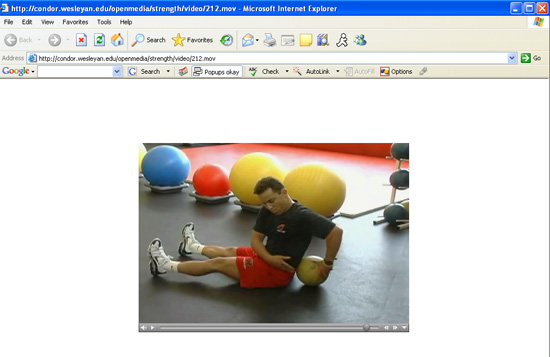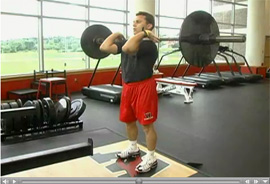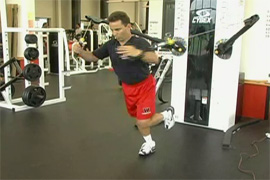Definitive Strength and Conditioning Moves Online
 |
| Drew Black, wrestling coach and strength and conditioning coach, explains how to use a medicine ball for strength training via video on a new Strength and Conditioning Web Site. |
| Posted 09/15/06 |
|
With moves like the spider lunge, chest fly, sumo squat, wood chop, push jerk and the inch worm, strength and conditioning lessons have never been so easy and entertaining.
Through a series of online videos and written training plans, Drew Black, Wesleyan wrestling coach and strength and conditioning coach, shows how to properly execute 241 movements in the weight room. Some can be applied in the workplace or at home, as well.
The new Strength and Conditioning Web Site, launched Sept. 7, can be seen online at http://www.wesleyan.edu/athletics/strength/. All high-quality video clip demonstrations were filmed in the Freeman Athletic Centers Andersen Fitness Center.
In addition to the video clips, the site highlights six performance principles including sport specific training, multiple joint movements, multiple plane movements, ground-based movements, nutrition, rest and recovery, and periodization, a scientific, systematic training model used to continuously make gains in training.
It offers training notes on speed and agility, general strength programs, warming up, core training. Site visitors can download and print log forms to chart and record training sessions.
Black suggests a number of general strength training programs, categorized into beginner, intermediate and advanced levels of strength training. Users can view a three-day program, weight training for total body, interval training ideas and a bodyweight strength program.
These programs are set up into two different formats where you may choose how you would like to train during the week, Black explains. You may like to train your total body each time you lift or you may choose to train only certain movements such as upper body pushing movements, lower body only, and upper body pulling movements. Both methods are effective for increasing strength. Its important to choose a plan that works best for you.
Black says the site also will attract top prospective student-athletes to Wesleyan.
There are not many sites around the country that offer this information, Black explains. It shows that we love what we do and at Wesleyan we strive for excellence.
The site was designed by Ryan Lee, Web designer; coordinated by Jen Carlstrom, director of New Media Services; and categorized by Mary Glynn, application technology specialist. Michael Leone, son of Pat Leone, World Wide Web administrator, filmed and edited the digital videos.
Black, who initiated the idea for a video-coach Web site, says strength and conditioning are the two best supplements a person can add into his or her daily regimen.
In order to run faster, jump higher, and be able to play longer, you must strength train, cross train, and condition your body, Black explains. Many of our fitness center users also have goals in terms of losing weight, become more flexible, get stronger, and put on some muscle. All of these goals will be realized and attained by following a strength program. Quality of life and quality experience in your sport are directly related to following a consistent strength and conditioning program.” |
| By Olivia Drake, The Wesleyan Connection editor |


 This new site is for the entire Wesleyan community, Black says. Our fitness center is one of the most used facilities on campus and I want everyone to have a tool and resource they can turn to for information on how to reach their strength and fitness goals whether you are a varsity athlete, a recreational athlete, a lifetime fitness enthusiast, or someone who is recovering from an injury.
This new site is for the entire Wesleyan community, Black says. Our fitness center is one of the most used facilities on campus and I want everyone to have a tool and resource they can turn to for information on how to reach their strength and fitness goals whether you are a varsity athlete, a recreational athlete, a lifetime fitness enthusiast, or someone who is recovering from an injury. Student athletes can use the site to enhance their individuals athletic potential on the field, mat, ice, court and water. Since strength training is a major supplement to the athletes specific sport, the athletes always have access to the video-coach as they train.
Student athletes can use the site to enhance their individuals athletic potential on the field, mat, ice, court and water. Since strength training is a major supplement to the athletes specific sport, the athletes always have access to the video-coach as they train.